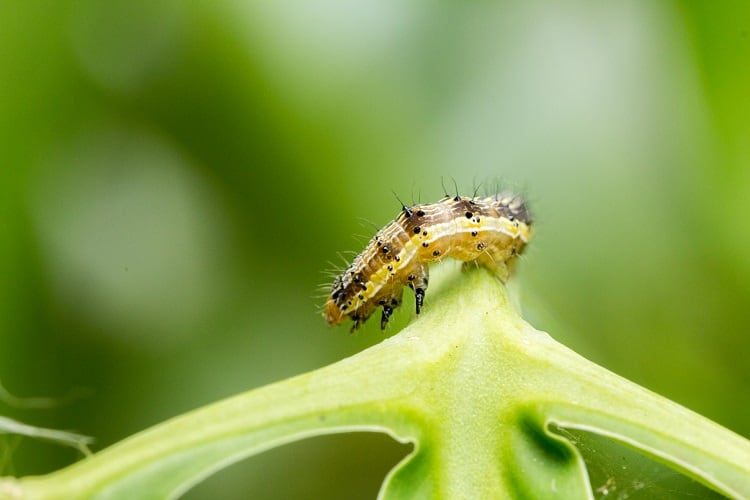As we get older, we might have changing tastes. We might move from drinking cola to wine, or from eating white chocolate to dark chocolate. According to a new study, the cotton bollworm also experiences such changing tastes, with the larvae and adult forms of the creature having different sugar-sensing systems.
A global pest, the cotton bollworm contributes approximately $3bn in economic loss to farmers each year. It is often hosted by plants such as tomatoes.
The worm has significantly different eating habits in its larval stage, where it eats the leaves, fruits and flower buds of plants, to its mature, adult stage, where it feasts on plants’ sugar-rich nectar. According to previous studies, the cotton bollworm’s external gustatory sensory neurons (GSNs) – which send taste signals to the brain – are found on the maxillary galea, an area around the mouth in larvae, but the antennae, the tarsi (leg segments furthest from the body), and the proboscis, which serves a similar structure as the human tongue, on the adult.
In the present study, researchers compared the behavioural and electrophysiological responses of both adult and larval cotton bollworms to seven different types of sugars found in plants, including glucose, fructose and sucrose.
They found that while both larvae and adults have GSN’s that detect sugar, they respond very differently. Larvae are between 100 and 1000 times more sensitive to sucrose than adults. This, the study suggests, could explain why young larvae are attracted to leaves rather than nectar – they can detect sucrose more effectively in areas where it’s scarce, such as plant tissue.
In the next stage of the study, researchers analysed nine sugar gustatory receptor (GR) genes in the larval and adult cotton bollworm taste organs, testing eight of them for reception to 11 different sugar compounds. Most showed no response, but one, GR10, was tuned to sucrose specifically, and another, GR6, responded to sucrose, fucose and fructose.
Lastly, using CRISPR/Cas9 DNA modifying techniques, the researchers created two mutant cotton bollworms, one that did not possess the function of the GR6, another that did not possess the function of GR10. They looked to detect changes in the electrophysiological and behavioural responses compared to typical cotton bollworms. From this analysis, the researchers found that GR10 plays a key role in larvae’s preference for sucrose, but GR6 influences the adult cotton bollworm’s sensing of sucrose, fucose and fructose.
Essentially, the research found that the varying ‘tastes’ of cotton bollworms are influenced by the fact that they use different sugar gustatory receptors to detect different levels of sugar. The more sensitive larvae can detect small amounts of sucrose using the GR10, while the less sensitive adult cotton bollworm detects high levels of not only sucrose but fructose and fucose using the GR6. These findings could help farmers work on pest control initiatives, although the researchers stress that research on all GRs involved in sugar sensation needs to be done.
“We’ve reported the molecular basis of sucrose reception in the eternal taste neurons of the cotton bollworm, and discovered that different taste receptors underlie the difference in food selection between the adult and larval stages,” said Chen-Zhu Wang, one of the study’s authors.
“GRs closely associated with Gr10 and Gr6 are also found in other moth and butterfly species. We therefore speculate that similar sugar-sensing mechanisms may also exist in these species, which is worth verifying with future research.”
Sourced From: eLife
'Sucrose taste receptors differ in larval and adult stages of a moth’
Published on: 7 November 2023
Doi: https://doi.org/10.7554/eLife.91711.1
Authors: S. Zhang, P. Wang, C. Ning, K. Yang, G. Li, L. Cao, L. Huang, C. Wang




